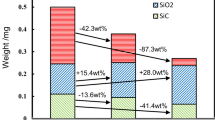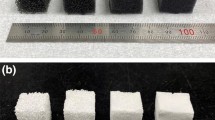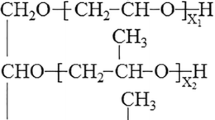Abstract
Large effective specific surface area reticulate porous ceramics (RPC) were fabricated by a polymeric foam replication process using of two-step route (presintering-recoating). The coating slurries used clay as the major material and silica sol etc. as a binder, while the recoating slurries consisted of lower concentration coating slurries and pore-forming materials such as starch or graphite. The solids-content of the recoating slurries which could effect on the porosity and the coating amount of sintered bodies was optimized in our work. Specific surface area and the pore size distribution of the RPC were measured by intrusive mercury curve. Morphological characteristics of the RPC were investigated by SEM. Comparing with the uncoated RPC, the recoated RPC had still highly porosity (80%) and a higher compressive strength. A lot of pores and apertures left on the surface of the sintered RPC’s after those starch/graphite pore-forming materials were burned out, thus lead to a remarkable increase in the specific surface area. The maximal effective specific surface area (ignore the pores size below 10 microns) of the recoated RPC is 0.52 m2/g, as over ten times as the uncoated RPC.
Similar content being viewed by others
References
Saggio-Woyaansky J., and Scottetal C.E., Processing of porous ceramics, Am. Ceram. Soc. Bull., 1992, 71(11): 1674.
Schwartzalder K., and Somers A.V., Method of Making Porous Ceramic Articles, U.S. Pat. 3090094, 1963.
Bhaduri S.B., Science and technology of ceramic foams, Adv. Performance Mater., 1994, 1: 205.
Williams E.J.A.E., and Evans J.R.G., Expanded ceramic foam, J. Mater. Sci., 1996, 31: 559.
Wang Shouren, Geng Haoran, Hui Linhai, and Wang Yingzi, Reticulated porous multiphase ceramics with improved compressive strength and fracture toughness, Journal of Materials Engineering and Performance, 2007, 16(1): 113.
Petrasch J., Fabian Meier, Hansmartin Friess, and Aldo Steinfeld, Tomography based determination of permeability, Dupuit-Forchheimer coefficient, and interfacial heat transfer coeffient in reticulate porous ceramics, Internatinal Journal of Heat and Fluid Flow, 2008, 29(1): 315.
Sebastian Zuercher, Kyra Pabst, and Georg Schaub. Ceramic foams as structured catalyst inserts in gas-particle filters for gas reactions-Effect of backmixing, Applied Catalysis A: General, 2009, 357(1): 85.
Taslicukur Z., Balaban C., and Kuskonmaz N., Production of ceramic foam filters for molten metal filtration using expanded polystyrene, Journal of the European Ceramic Society, 2007, 27(2–3): 637.
Julien Lévêque, David Rouzineau, Michel Prévost, and Michel Meyer, Hydrodynamic and mass transfer efficiency of ceramic foam packing applied to distillation, Chemical Engineering Science, 2009, 64(11): 2607.
Bucharsky E.C., Schell G., Oberacker R., and Hoffmann M.J., Anatase-rutile transformation in TiO2-V2O5 catalyst coatings for ceramic foams, Journal of the European Ceramic Society, 2009, 29(10): 1955.
Zhang Yong, Li Xiaoyu, Feng Fan, Lin Yunfeng, Liao Yunmao, Tian Weidong, and Liu Lei, Cell adhesive ability of a biological foam ceramic with surface modification, Applied Surface Science, 2008, 255(2): 409.
Miao X., Hu Y., Liu J., and Wong A.P., Porous calcium phosphate ceramics prepared by coating polyurethane foams with calcium phosphate cements, Materials Letters, 2004, 58(3–4): 397.
Song Zhengchang, and Lin Boquan, Numerical simulation of excess-enthalpy combustion flame propagation of coal mine methane in ceramic foam. Mining Science and Technology (in Chin.), 2010, 20(2): 248.
Colombo P., Ceramic foams fabrication, properties and applications, Key Eng. Mater., 2002, 206–213: 1913.
Ignacio Moreno-Garrido, Microalgae immobilization: Current techniques and uses, Bioresource Technology, 2008, 99(10): 3949.
Cheng Jiangfeng, Su Zhongliang, Liang Chengwei, and YE Qingguo, Immobilization technology of Saccharomyces cerevisiae in foam ceramic, China Brewing, 2009, (3): 109.
Wang Yi, Development and Application of a Porous Carrier Used in Biofilm Reactors. Ph. D. dissertation, Xi’an University of Architecture and Technology, 2004.
Tian Weijun, Study on the Mechanism and Test of Biological Hardening Purification Directly for Polluted Streams. Ph. D. dissertation, Hehai University, 2005.
Ravault, Frank Ernest George, Production of Porous Ceramic Materials. United States Patent. Number: 4004 933, Date: Jan: 25, 1977.
Zhu Xinwen, Jiang Dongliang, Tan Shouhong, and Zhang Zhaoquan, Preparation of reticulated porous ceramics with a controlled pore structure, Journal of Inorganic, 2002, 17(1): 79.
Author information
Authors and Affiliations
Corresponding author
Rights and permissions
About this article
Cite this article
Zhou, M., Zeng, L., Cheng, X. et al. Preparation of large effective specific surface area reticulate porous ceramics by polymeric foam replication process using recoating technique. Rare Metals 30 (Suppl 1), 418–421 (2011). https://doi.org/10.1007/s12598-011-0316-3
Received:
Revised:
Accepted:
Published:
Issue Date:
DOI: https://doi.org/10.1007/s12598-011-0316-3




